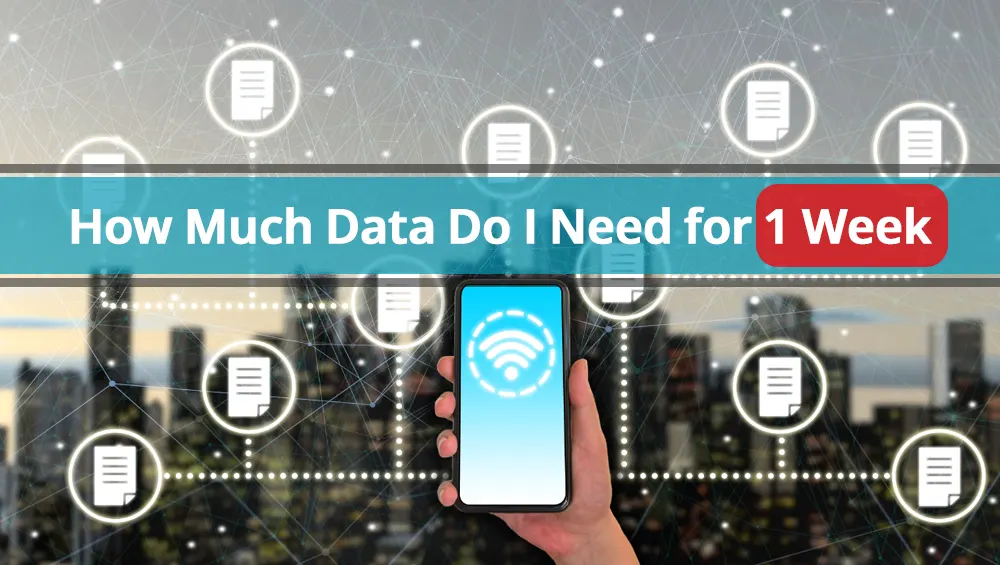Table of Contents
ToggleHow much data do I need for basic internet browsing for a week?
For basic internet browsing, you would typically need around 1 to 5 GB of data for a week. This includes activities like checking emails, browsing websites, and using social media apps. However, if you frequently stream videos or download large files, you may need more data.
Are you planning a trip and wondering how much data you’ll need to stay connected without overspending on your phone bill? In this comprehensive guide, we will explore all the factors that influence your data consumption, from the type of activities you plan to do online to your destination. We’ll also dive into the amount of data used by popular apps and activities such as web browsing, social media, and video calling.
Additionally, we’ll help you calculate your travel needs based on various factors and provide insights into how 5G impacts your usage, including cell phone data allowance. By the end of this guide, you’ll have a better understanding of how much data is required for one week, so you can enjoy your trip without worrying about exceeding your limit.

Factors Influencing Data Consumption
Different online activities consume varying amounts of information. Streaming videos or music, browsing social media, sending emails, and more can all impact information consumption. The quality settings of videos, music, and images also play a role, as higher settings require more information. Additionally, the number of devices connected to the same internet connection can affect information usage.
The longer you spend on an activity or website, the more information you will consume. It’s important to consider how much internet data your plan allows, as it will limit how much information you can use within a given period.
The type of activities you plan to do online
When it comes to your internet usage, the type of activities you plan to do online plays a crucial role in determining how much data you’ll need. Streaming video content, for instance, requires higher usage compared to browsing social media or sending emails, which do not use up very much data. Similarly, activities like online gaming and video conferencing also consume a fair amount.
Downloading big files, such as software updates or movies, can quickly use up your allocation. Additionally, using location-based services and GPS navigation can contribute to your usage. It’s important to assess your online activities and plan accordingly to avoid exceeding your limit and incurring extra charges.
The length of your trip
When planning your trip, it’s important to consider the length of your stay and how it may impact your internet consumption. The longer your trip, the more online activities you are likely to engage in. This is because longer trips may require more bandwidth for navigation, communication, and entertainment purposes. To reduce internet usage on longer trips, consider downloading offline maps and content or using apps that can help you control your internet consumption.
While shorter trips may require less bandwidth, it’s always better to have a buffer to avoid overage charges. Additionally, your online needs may vary depending on the destination and the availability of Wi-Fi.
Your destination
When it comes to data usage during your travels, different destinations can have varying levels of data consumption. This can depend on factors such as local networks, connectivity, and the demand for internet traffic in high-traffic tourist areas. Rural areas, on the other hand, may have lower data usage due to fewer users and less connectivity.
It’s essential to research your destination’s network coverage, understand their data plans and rates, and consider factors like streaming, downloading, and social media use, which can impact your data consumption while abroad. Additionally, you can save mobile data by using free wifi in your accommodation or a cafe, but be cautious as there are risks in using public networks.
Data Usage by Apps and Activities
Social media platforms like Facebook, Instagram, and Twitter can consume a significant amount of data, particularly when streaming videos or uploading media. Streaming music services such as Spotify and Apple Music utilize data, with usage varying based on quality settings and music consumption. Video calling apps like FaceTime, Skype, and WhatsApp also use up your data, with video calls consuming more compared to voice calls.
Online gaming typically requires a substantial amount of data, especially for multiplayer games featuring high-quality graphics. On the other hand, web browsing, email, and navigation apps like Google Maps consume different amounts of data, depending on the specific app and activity.
Web browsing
When browsing the web, it’s important to be mindful of your internet usage limit. Web browsing can quickly consume your allotted data, particularly if you visit media-rich pages. Streaming videos and music while browsing adds up to significant usage as well. To minimize consumption, consider using mobile versions of websites or disabling video auto-play. Features like compression or ad-blocking can also help reduce usage.
To stay within your limits, keep track of your usage through your phone’s settings or a dedicated app. By being cautious about web browsing, you can make the most of your internet without exceeding your limits.
How much data is needed for an Email check?
Email checking consumes minimal data, typically less than 1MB per hour. However, the usage may increase if you have large attachments or images to download. Email apps like Gmail and Outlook offer options to reduce data consumption, such as disabling image auto-downloading. In general, email checking is a low-data activity that won’t significantly impact your weekly data package usage.
How much data does social media use?
Social media apps consume data for various activities such as browsing, uploading media, streaming videos, and downloading content. The amount of data used depends on factors like video quality settings, autoplay settings, and media consumption. Using Wi-Fi whenever possible and adjusting settings can help conserve data while using social media apps.
Data usage for streaming music and videos
When it comes to streaming music and videos, usage can vary depending on the quality settings and streaming platform. Popular music streaming services like Spotify, Apple Music, and Amazon Music allow users to choose between different streaming quality options, such as normal, high, or highest quality. The higher the quality, the more consumption it requires.
Similarly, video streaming services like Netflix, YouTube, and Hulu offer varying video quality settings, with higher quality settings using more per minute of streaming. To optimize usage, consider using streaming services that offer data-saving settings, such as lower video quality or audio-only streaming. Additionally, monitoring usage within streaming apps and adjusting settings accordingly can help manage consumption.
So, if you’re someone who loves to stream music while on the go, make sure to keep an eye on your data usage and adjust your settings accordingly to avoid going over your limit.
How much data do video calls use?
Video calling apps, such as FaceTime and Skype, consume varying amounts of information depending on factors like video quality, call duration, and internet connection. High-definition video calls use more bandwidth compared to standard quality.
Voice calls, also known as phone calls, including VoIP calls, generally use less data. To manage your data usage, limit video calls, reduce video quality settings, and utilize Wi-Fi whenever possible. Checking your usage settings within the apps provides insights into data consumption.
Summary of Data Use
Here’s a general breakdown of data usage for common travel activities:
- Web browsing: 1-3 MB per minute
- Email checking: 0.1-0.5 MB per email
- Social media: 5-10 MB per minute
- Video streaming: 150-300 MB per minute
- Music streaming: 50-100 MB per hour
Recommended Data Plans for a Week’s Travel
Based on these estimations, here are some recommended data plans for a week’s travel:
- Light user (occasional web browsing and social media): 1-2 GB
- Moderate user (regular web browsing, social media, and music streaming): 2-5 GB
- Heavy user (frequent video streaming and gaming): 5 GB or more
Calculating Your Travel Data Needs
When planning your travel, it’s important to consider various factors that influence your connectivity needs. These factors include the duration of your trip, the destinations you’ll be visiting, and your usage habits. To estimate your online activity needs, think about the different activities you’ll be engaging in, such as navigation, social media, messaging, streaming, and web browsing.
Take into account the varying amounts of data consumed by different services, apps, and activities. By calculating your travel connectivity needs, you can choose an appropriate package that ensures you have enough coverage for your entire travel period.
How 5G Impacts Your Data Usage
5G networks have a significant impact on your internet usage. These networks provide faster speeds, enabling quicker downloads and streaming. However, it’s important to note that with these faster speeds, you may use up your allowance more quickly, especially when streaming high-definition videos or gaming online.
Additionally, 5G technology opens up new possibilities for services like augmented reality and virtual reality, which can require larger amounts of data. While 5G availability may still be limited, it’s worth considering plans that offer unlimited or higher allowances to fully utilize the benefits of 5G.
Does 5G use more data than 4G?
5G technology doesn’t inherently consume more information than 4G, but it enables faster speeds, potentially leading to increased usage. Activities like streaming HD videos and online gaming may require more consumption of information on 5G due to faster download speeds.
However, actual usage depends on individual device usage and app/service choices, regardless of network technology. Monitoring and optimizing settings can help manage consumption on both 4G and 5G networks. Consider plans that suit your usage habits.
Frequently Asked Questions for How Much Data Do I Need for 1 Week
Is 5GB of data enough for a week?
5GB of data can be sufficient for a week, depending on your usage. If you mainly use your phone for social media and messaging, it may be enough for a week of internet use. However, if you plan to stream videos or use high-data apps, 5GB might not be sufficient. Keep track of your data usage and adjust your plan accordingly.
Conclusion
To estimate your weekly online activity, consider factors like the type of web-based pursuits, trip duration, and destination. Different apps and activities consume varying digital capacities, such as browsing the internet, checking email, using social media, listening to music, watching videos, and video calling. Take all these factors into account when calculating your digital needs.
Note that the introduction of 5G technology may impact internet usage. While it offers faster speeds, it doesn’t necessarily mean more consumption compared to 4G. Keep this in mind when estimating your online requirements.
Understanding your digital needs allows you to make informed decisions about your mobile plan and avoid unexpected charges. Plan accordingly to ensure you have enough capacity to stay connected during your travels.


